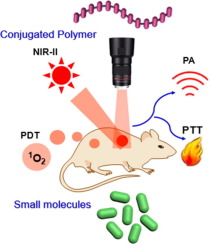Coordination Chemistry Reviews ( IF 20.3 ) Pub Date : 2020-04-09 , DOI: 10.1016/j.ccr.2020.213318 Jun Li , Yi Liu , Yuling Xu , Lin Li , Yao Sun , Wei Huang

|
Fluorescence imaging with deep penetration and low auto-fluorescence in the second near-infrared biochannel (NIR-II, 1000–1700 nm) was developed rapidly during the past decades. Organic materials such as organic small molecules and polymers are promising candidates for various biomedical studies owing to their low toxicity and facile chemical modification. Recently, scaffold-structural diversity and multifunctional utilization of NIR-II fluorophores attracted a lot of attentions as the gradually revealing shortcomings of first generation NIR-I organic fluorophores and unbalanced demand between single fluorescence imaging and clinical practice. In this review, organic emitters including NIR-II organic small molecules and polymers are discussed which focus on their multifunctional applications in biomedicine. Furthermore, we raised the current challenges and perspectives of NIR-II organic emitters.
中文翻译:

用于生物医学的NIR-II有机发射体开发的最新进展
在过去的几十年中,第二个近红外生物通道(NIR-II,1000-1700 nm)中具有深层穿透和低自发荧光的荧光成像发展迅速。有机材料,如有机小分子和聚合物,由于其低毒性和易于化学修饰而成为各种生物医学研究的有希望的候选者。近来,随着第一代NIR-I有机荧光团的不足逐渐显现出来,以及单一荧光成像与临床实践之间需求的不平衡,NIR-II荧光团的支架结构多样性和多功能利用引起了人们的广泛关注。在这篇综述中,讨论了包括NIR-II有机小分子和聚合物在内的有机发射体,这些发射体侧重于它们在生物医学中的多功能应用。此外,











































 京公网安备 11010802027423号
京公网安备 11010802027423号